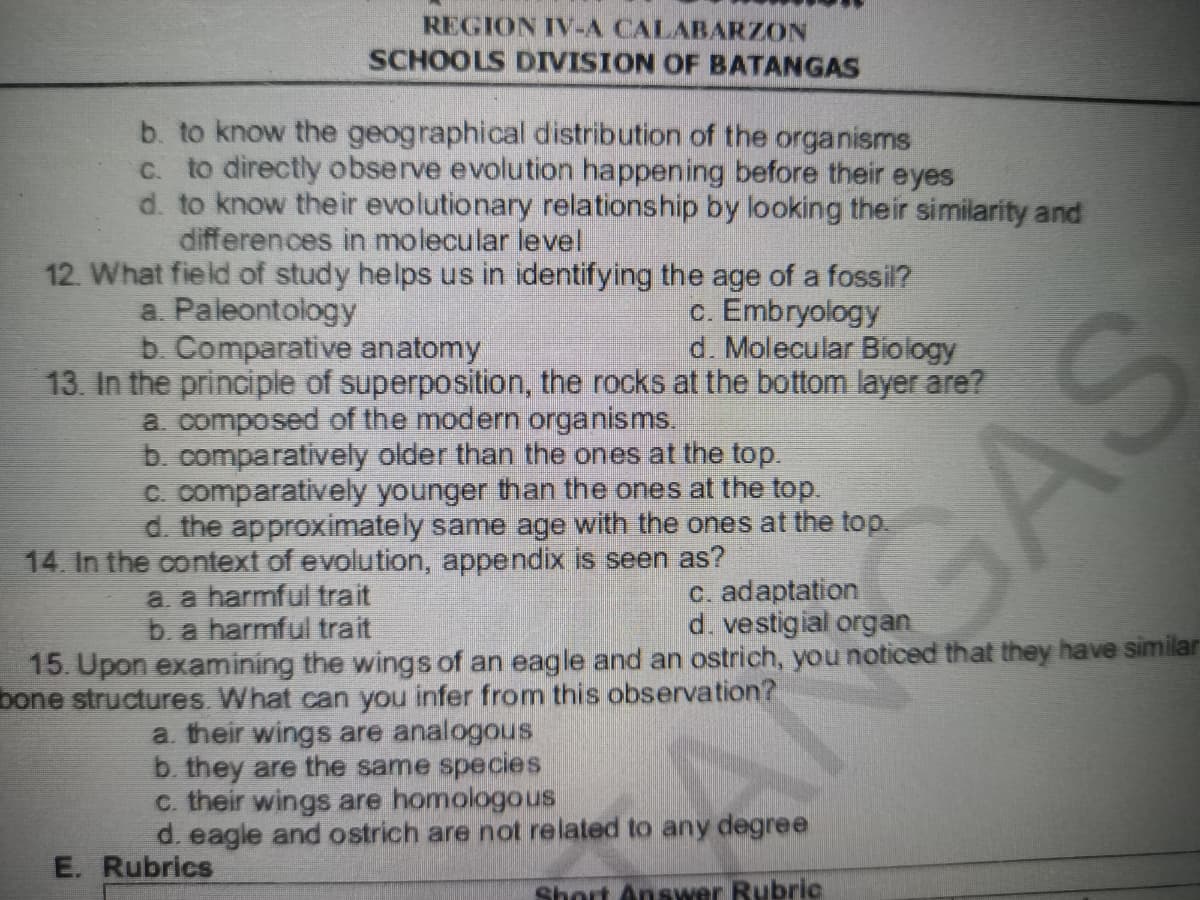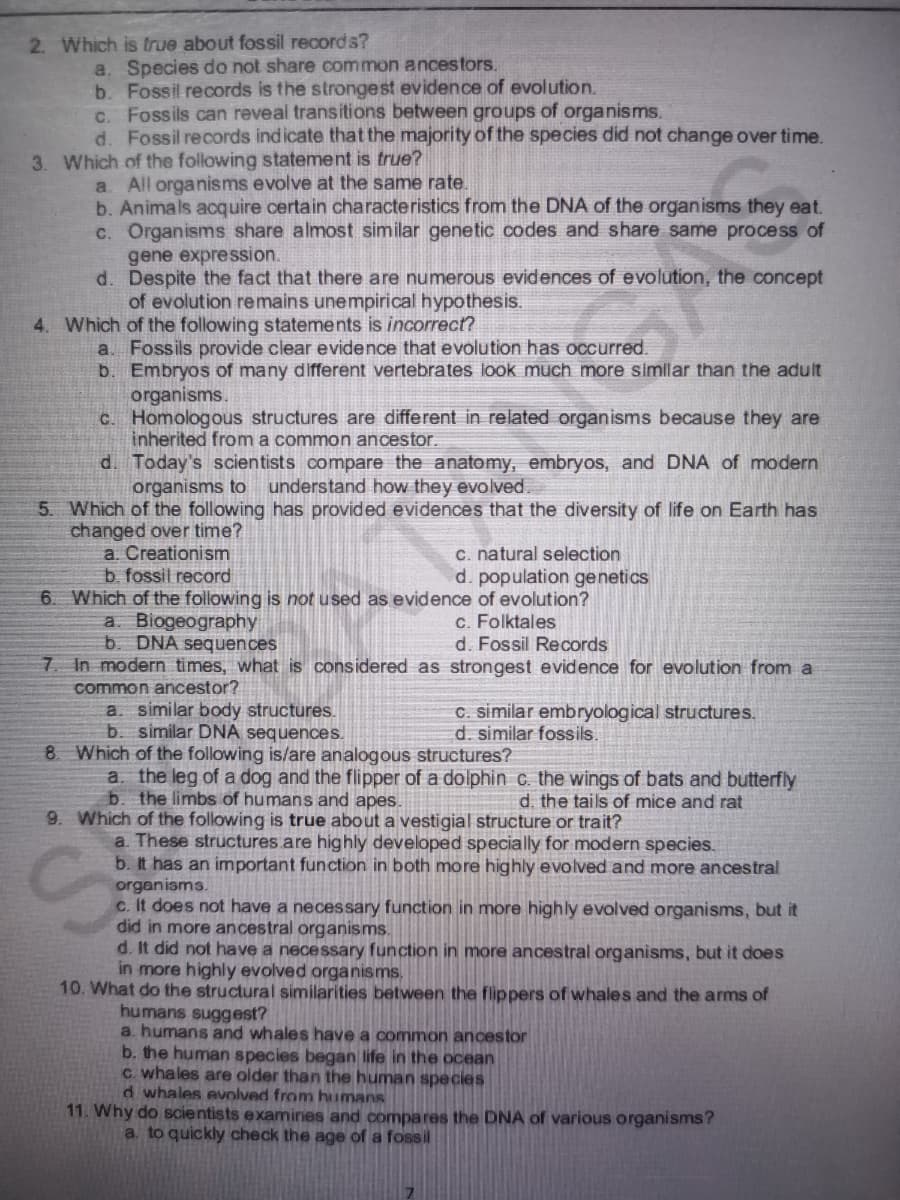12. What field of study helps us in identifying the age of a fossil? a. Paleontology b. Comparative anatomy 13. In the principle of superposition, the rocks at the bottom layer are? a. composed of the modern organisms. b. comparatively older than the ones at the top. C. comparatively younger than the ones at the top. d. the approximately same age with the ones at the top. c. Embryology d. Molecular Biology 14. In the context of evolution, appendix is seen as? a. a harmful trait b. a harmful trait c. adaptation d. vestigial organ at they have sim GAS
12. What field of study helps us in identifying the age of a fossil? a. Paleontology b. Comparative anatomy 13. In the principle of superposition, the rocks at the bottom layer are? a. composed of the modern organisms. b. comparatively older than the ones at the top. C. comparatively younger than the ones at the top. d. the approximately same age with the ones at the top. c. Embryology d. Molecular Biology 14. In the context of evolution, appendix is seen as? a. a harmful trait b. a harmful trait c. adaptation d. vestigial organ at they have sim GAS
Concepts of Biology
1st Edition
ISBN:9781938168116
Author:Samantha Fowler, Rebecca Roush, James Wise
Publisher:Samantha Fowler, Rebecca Roush, James Wise
Chapter12: Diversity Of Life
Section: Chapter Questions
Problem 11RQ: Which assumption of cladistics is stated incorrectly? a. Living things are related by descent from a...
Related questions
Question
Please I'm begging you, help me with these. I can't understand a single thing about our topic and I want to read explanations for each questions, it woukd really help and enlighten me! Thank you very much, someone please :((((

Transcribed Image Text:REGION IV-A CALABARZON
SCHOOLS DIVISION OF BATANGAS
b. to know the geographical distribution of the organisms
C. to directly observe evolution happening before their eyes
d. to know their evolutionary relationship by looking their similarity and
differences in molecular level
12. What field of study helps us in identifying the age of a fossil?
a. Paleontology
b. Comparative anatomy
13. In the principie of superposition, the rocks at the bottom layer are?
a composed of the modern organisms.
b. comparatively older than the ones at the top.
C. comparatively younger than the ones at the top.
d. the approximately same age with the ones at the top.
c. Embryology
d. Molecular Biology
14. In the context of evolution, appendix is seen as?
a. a harmful trait
b. a harmful trait
c. adaptation
d. vestigial organ
15. Upon examining the wings of an eagle and an ostrich, you noticed that they have similar
bone structures. What can you infer from this observation?
a. their wings are analogous
b. they are the same species
c. their wings are homologous
d. eagle and ostrich are not related to any degree
E. Rubrics
Short Answer Rubric
GAS

Transcribed Image Text:did in more ancestral organisms.
2. Which is true about fossil records?
a. Species do not share common ancestors.
b. Fossil records is the strongest evidence of evolution.
C. Fossils can reveal transitions between groups of organisms.
d. Fossil records indicate that the majority of the species did not change over time.
3. Which of the following statement is true?
a All organisms evolve at the same rate.
b. Animals acquire certain characteristics from the DNA of the organisms they eat.
c. Organisms share almost similar genetic codes and share same process of
gene expression.
d. Despite the fact that there are numerous evidences of evolution, the concept
of evolution remains unempirical hypothesis.
4. Which of the following statements is incorrect?
a. Fossils provide clear evidence that evolution has occurred.
b. Embryos of many different vertebrates look much more similar than the adult
organisms.
C. Homologous structures are different in related organisms because they are
inherited from a common ancestor.
d. Today's scientists compare the anatomy, embryos, and DNA of modern
organisms to
understand how they evolved.
5. Which of the following has provided evidences that the diversity of life on Earth has
changed over time?
a. Creationism
b. fossil record
c. natural selection
d. population genetics
6. Which of the following is not used as evidence of evolution?
c. Folktales
d. Fossil Records
a. Biogeography
b. DNA sequences
7. In modern times, what is considered as strongest evidence for evolution from a
common ancestor?
a. similar body structures.
b. similar DNA sequences.
C. similar embryological structures.
d. similar fossils.
8. Which of the following is/are analogous structures?
a. the leg of a dog and the flipper of a dolphin c. the wings of bats and butterfly
b. the limbs of humans and apes.
d. the tails of mice and rat
9. Which of the following is true about a vestigial structure or trait?
a. These structures.are highly developed specially for modern species.
b. It has an important function in both more highly evolved and more ancestral
organisms.
c. It does not have a necessary function in more highly evolved organisms, but it
d. It did not have a necessary function in more ancestral organisms, but it does
in more highly evolved organisms.
10. What do the structural similarities between the flippers of whales and the arms of
humans suggest?
a. humans and whales have a common ancestor
b. the human species began life in the ocean
c whales are older than the human species
d whales evolved from humans
11. Why do scientists examines and compares the DNA of various organisms?
a. to quickly check the age of a fossil
Expert Solution
This question has been solved!
Explore an expertly crafted, step-by-step solution for a thorough understanding of key concepts.
This is a popular solution!
Trending now
This is a popular solution!
Step by step
Solved in 2 steps

Knowledge Booster
Learn more about
Need a deep-dive on the concept behind this application? Look no further. Learn more about this topic, biology and related others by exploring similar questions and additional content below.Recommended textbooks for you

Concepts of Biology
Biology
ISBN:
9781938168116
Author:
Samantha Fowler, Rebecca Roush, James Wise
Publisher:
OpenStax College

Biology (MindTap Course List)
Biology
ISBN:
9781337392938
Author:
Eldra Solomon, Charles Martin, Diana W. Martin, Linda R. Berg
Publisher:
Cengage Learning


Concepts of Biology
Biology
ISBN:
9781938168116
Author:
Samantha Fowler, Rebecca Roush, James Wise
Publisher:
OpenStax College

Biology (MindTap Course List)
Biology
ISBN:
9781337392938
Author:
Eldra Solomon, Charles Martin, Diana W. Martin, Linda R. Berg
Publisher:
Cengage Learning


Biology: The Dynamic Science (MindTap Course List)
Biology
ISBN:
9781305389892
Author:
Peter J. Russell, Paul E. Hertz, Beverly McMillan
Publisher:
Cengage Learning